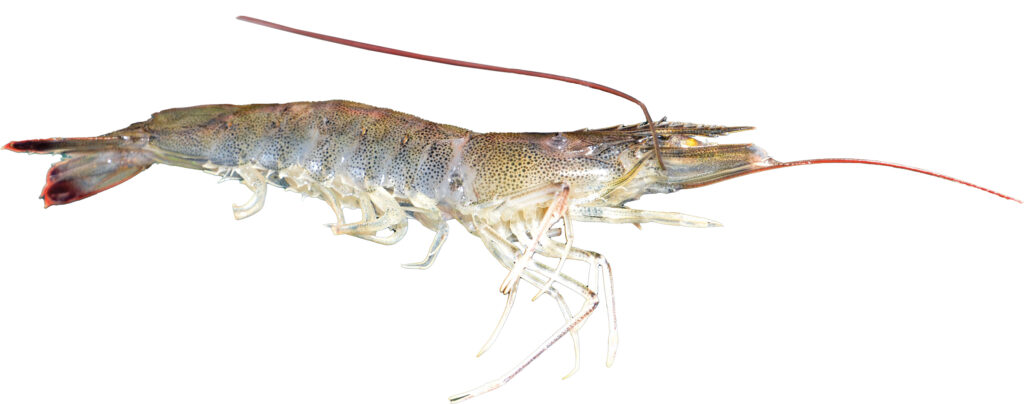Like a scene from a classic Alfred Hitchcock movie, swarming, squawking birds began their attack, swooping low over the waters churning with activity beneath them.
Below the surface, speckled trout herded shrimp to the surface. Sharp-eyed birds quickly spotted the ruckus and pounced on panicked shrimp to get their share of protein.
“Nothing gets fish in a frenzy like a shrimp migration,” says Bobby Abruscato with A-Team Fishing Adventures. “If I happen to see birds diving, I’ll go check it out to see what’s there. Birds hover right over the surface waiting for a shrimp to jump so they can get it.”

Two shrimp species, white and brown, migrate in and out of the marshes and estuaries to and from the Gulf of Mexico each year. White shrimp run to deeper water in the Gulf after a good cold snap, usually in early to mid-October. In Mobile Bay, the white shrimp migration lasts throughout the fall. When the shrimp move, every carnivore follows to fill their bellies.
“In the fall, white shrimp usually stay in the rivers and upper estuaries until we start getting some good cold fronts to kickstart their migration,” says Craig Newton, a biologist with the Alabama Marine Resources Division on Dauphin Island. “Then, they migrate out of the rivers and into Mobile Bay, Mississippi Sound and the Gulf of Mexico. White shrimp don’t necessarily go straight offshore like brown shrimp do.”
White shrimp spawn offshore during June, July and August, generally staying closer to the coastline than brown shrimp. The eggs drift inshore with the winds and tides where developing juveniles hide among the marsh grasses. White shrimp can tolerate fresher water than browns and venture farther up the estuaries and coastal rivers. White shrimp generally swim a little higher in the water while brownies prefer to stay closer to the bottom and sometimes even bury themselves in the mud.
“In the fall, we see a lot of bird activity up in the Mobile-Tensaw Delta,” Abruscato says.
Brown shrimp also spawn offshore. They stay in the estuaries until they grow to about a 50- to 80-count size, or 50 to 80 shrimp per pound. Then, they start their migration to the Gulf, normally in mid-May to June.
“Brown shrimp go anywhere from five and 50 miles offshore to spend the remainder of their lives,” Newton says. “When spring comes again, they spawn and continue the cycle. After about 20 days, larval shrimp should be inside Mobile Bay, Mississippi Sound or in the marshes. Post-larval shrimp use the marsh edges and submerged aquatic vegetation as their nursery habitat.”
Both species live less than two years, if nothing eats them. Because so many things eat the “bread of the sea,” shrimp must reproduce prolifically. One female shrimp can produce 500,000 to a million eggs at a time. Each species can grow to about seven inches long.
Since the fall white shrimp migration lasts longer, moves slower and the crustaceans don’t travel as far, this time ordinarily provides the best fishing opportunities. Many anglers use live or fresh shrimp for bait. Everything living in salt water along the Alabama coastline eats shrimp. When fishing with shrimp, the catch might include speckled trout, redfish, white trout, flounder, sheepshead, black drum, croaker and other species.
“Watching the birds is a good way to find speckled trout,” Abruscato says. “In Alabama, birds are normally diving on shrimp. We typically see more birds diving on bait in the spring and the fall, but that doesn’t mean it can’t happen any time of the year. In the right spot, it gets insane. People can catch a limit of trout quickly because the fish are in a feeding frenzy.”
In the delta marshes, freshwater species like largemouth bass can tolerate some salinity. Salty species like redfish and flounder can live in fresh water. Diverse species commonly live next to each other. Often, anglers fishing the same spot will catch bass, redfish and flounder on the same baits on subsequent casts. Largemouth bass will devour live shrimp anytime they can find them.
When it comes to putting fish in the boat during a crustacean migration, no other temptations can compete with a shrimp. In the absence of natural bait, anglers can use soft-plastic shrimp imitations in a variety of ways. When fish key on shrimp and get in a frenzy, they might hit anything that crosses their noses.
John N. Felsher is a professional freelance writer who lives in Semmes, Ala. He also hosts an outdoors tips show for WAVH FM Talk 106.5 radio station in Mobile, Ala. Contact him at [email protected] or through Facebook.




